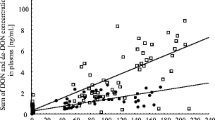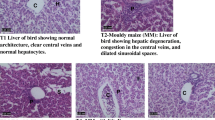Abstract
The effects of feeding a Fusarium toxin contaminated maize (CM) to laying hens were studied in a 16-week lasting experiment. The CM contained 17630 μg deoxynivalenol (DON) and 1580 μg zearalenone (ZON) per kg.
Animal performance, serum chemical parameters, antibody titers to Newcastle disease virus (NDV) in serum, antibody titers to fimbrien antigen K88 in egg yolk, and ZON residues in eggs and tissues were investigated.
Moreover, Mycofix® Plus (MP), a so-called detoxifying agent, was added both the non-contaminated control (M) and to the CM diet. Each of the four resulting diets (M, M-MP, CM, CM-MP) was tested on 25 laying hybrids (Lohmann Brown).
Hens fed the CM- and the CM-MP diet had a significantly depressed feed intake compared to the control groups of about 5 percent, mainly due to the effects observed at the beginning of the experiment.
Daily egg mass production per hen was 56.6 g, 58.4 g, 53.9 g and 55.2 g in groups M, M-MP, CM and CM-MP, respectively. The main factors (maize contamination, MP-addition) were significant, whereas interactions were insignificant, suggesting a mycotoxin-independent effect of MP.
Feeding of the CM-diets resulted in a significant decrease in serum titers to NDV and to an increase in yolk titers to antigen K88.
No residues of ZON or of its metabolites were found in yolk, albumen, abdominal fat, breast meat, follicles greater than one cm in diameter, ovaries including follicles smaller than one cm in diameter, magnum or serum. ZON and α-zearalenol (α-ZOL) were detected in the livers of hens fed the CM-diets at mean concentrations of 2.1 μg/kg and 3.7 μg/kg, respectively.
It was concluded that the feeding of maize highly contaminated with Fusarium mycotoxins adversely influenced performance of the hens and modulated immune response. At the given level of zearalenone and at the detection limits (0.5–2 μg/kg), no residues of ZON or its metabolites were found in eggs. The effects of the tested detoxifying agent were found to be independent of mycotoxins.
Similar content being viewed by others
References
German Federal Ministry of Consumer Protection, Food and Agriculture (2000) Orientation values for critical concentrations of deoxynivalenol and zearalenone in diets for pigs, ruminants and gallinaceous poultry. VDM 27/00, pp. 2–3.
Dailey RE, Reese RE, Brouwer EA (1980) Metabolism of [14C] zearalenone in laying hens. J. Agric. Food Chem. 28:286–291.
Pasteiner S (1998) Mycotoxins in animal husbandry. Biomin Gesunde Tierernährung International GesmbH, Erber AG, Austria
Ueberschär K-H (1999) Einfluß von Zearalenon auf Wachstum und Rückstände in den Geweben von Mastkaninchen. VDLUFA-Kongreßband 1999, Halle/Saale, VDLUFA-Schriftenreihe 52/1999, pp. 425–428.
Kubena LF, Harvey RB, Corrier DE, Huff WE, Phillips TD (1987) Effects of feeding deoxynivalenol (DON, vomitoxin)-contaminated wheat to female white leghorn chickens from day old through egg production, Poultry Sci. 66:1612–1618.
Author information
Authors and Affiliations
Rights and permissions
About this article
Cite this article
Dänicke, S., Ueberschär, KH., Halle, I. et al. On the effects of Fusarium toxin contaminated maize in laying hen feeding. Mycotox Res 17 (Suppl 1), 62–66 (2001). https://doi.org/10.1007/BF03036714
Published:
Issue Date:
DOI: https://doi.org/10.1007/BF03036714




